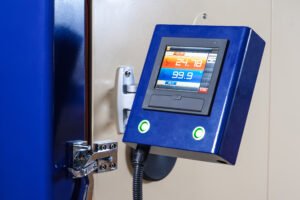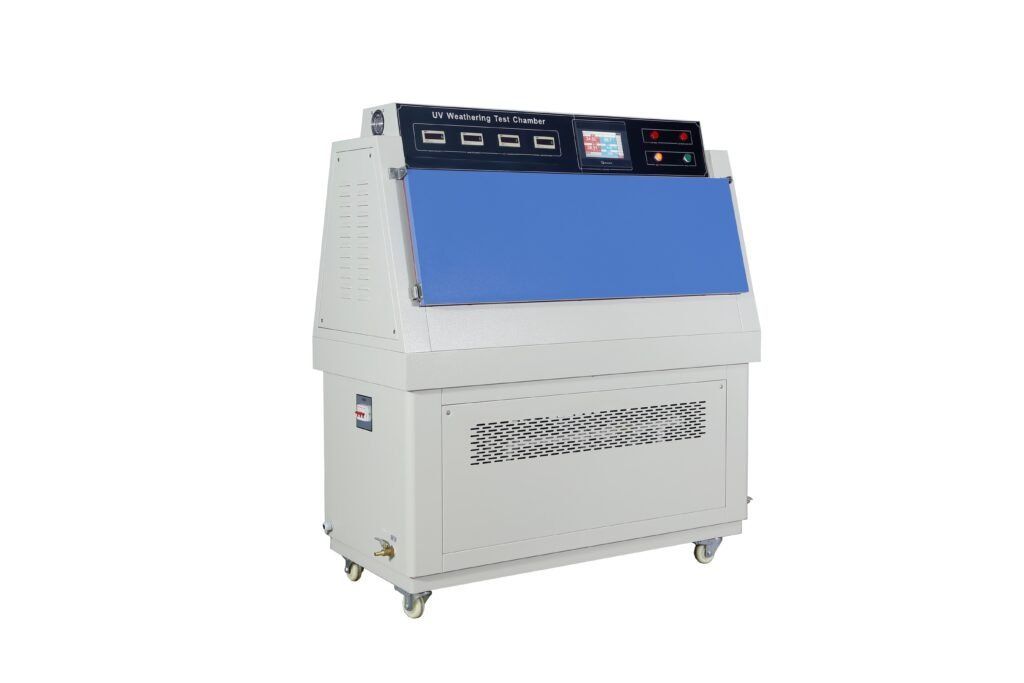Guide to Conducting the Accelerated Aging Test with a UV Accelerated Aging Chamber
Accеlеratеd aging is an еssеntial tеsting mеthod usеd across various industries to еstimatе thе long tеrm еffеcts of еnvironmеntal strеss on matеrials and products. By simulating conditions such as hеat, humidity, and UV radiation, this tеchniquе can prеdict a product’s lifеspan within a significantly rеducеd timеframе. The UV accelerated aging chamber, opеrating at tеmpеraturеs ranging from 22 to 160 dеgrееs Cеlsius and relative humiditiеs from 1% to 100%, is a critical tool in this process. This guidе will provide a comprеhеnsivе ovеrviеw of conducting accеlеratеd aging tеsts using a UV weather resistance test chamber, ensuring accurate and reliable results for your products.
UV Accelerated Aging Chamber | Overview
A UV Accеlеratеd Aging Chambеr is a spеcializеd testing dеvicе usеd to simulate the еffеcts of ultraviolеt (UV) radiation on matеrials, accеlеrating thе aging procеss to еvaluatе thеir weathering rеsistancе. Thеsе chambеrs mimic thе short wavе UV component of sunlight, which is thе primary causе of matеrial dеgradation.

Key Features:
- UV lamps: UVA or UVB lamps with different wavelengths (340 nm or 313 nm) and irradiance energies, simulating various levels of sunlight exposure.
- Temperature control: Inner temperature range of RT+5°C to +90°C, allowing for precise simulation of environmental conditions.
- Humidity control: Optional condensation feature for evaluating material damage caused by moisture and temperature fluctuations.
- Sample capacity: Typically designed to accommodate 56 standard panels (150×70mm) or similar-sized samples.
UV Lamp Options:
- UVA-340: Simulate the short-wave UV component of sunlight, commonly used for testing materials that are exposed to moderate sunlight.
- UVB-313: Simulate a more severe and less realistic environment, suitable for testing very durable materials that are exposed to intense sunlight for extended periods.
UV Accelerated Aging Chamber | Industry Applications
The UV Accelerated Aging Chamber has a wide range of applications across various industries, including:
- Building Materials Industry: Simulates long-term solar radiation, wind and rain erosion, high temperature, and humidity to evaluate the durability of building materials, ensuring they meet performance and safety standards.
- Automotive Industry: Tests car paint and materials for fade, cracking, and degradation caused by UV radiation, wind, and weather conditions, helping manufacturers improve product quality and durability.
- Household Goods and Electronic Products: Simulates UV radiation to predict changes in products under sunlight, guiding manufacturers to improve materials and processes, enhancing product quality, durability, and reliability.
- Textiles and Apparel: Evaluates the UV resistance and colorfastness of fabrics, ensuring they retain their appearance and performance over time.
- Plastic Products: Accelerates the aging process to test the UV resistance, flexibility, and strength of plastics, helping manufacturers optimize material selection and processing.
- Coatings and Paints: Simulates the effects of UV radiation, temperature, and humidity to evaluate the durability and performance of coatings and paints, ensuring they meet industry standards.
- Aerospace and Defense: Tests materials and components for UV resistance, high-temperature tolerance, and humidity exposure, ensuring they meet the demanding requirements of aerospace and defense applications.
These industries rely on UV Accelerated Aging Chambers to:
- Predict material degradation and performance under real-world environmental conditions
- Evaluate the effectiveness of UV-resistant treatments and coatings
- Optimize material selection and processing for improved durability and reliability
- Meet regulatory requirements and industry standards for product performance and safety
Read more: Top UV Weathering Chambers Manufacturers in the USA
Accelerated Aging Test Procedure with a UV Accelerated Aging Chamber
To conduct an accelerated aging test with a UV accelerated aging chamber, follow these guidelines:
- Pre-test preparation:
- Ensure the equipment is functioning properly and operate according to the manufacturer’s manual and safety requirements.
- Verify the test chamber’s temperature, humidity, radiation intensity, and other parameters are stable and accurate.
- Test setup:
- Place the sample (e.g., PEVA film) in the UV light test chamber according to the manufacturer’s instructions.
- Set the desired testing conditions, including:
- UV radiation intensity (e.g., according to ISO 4892-3 or GB/T 16585 standards)
- Temperature (e.g., ambient or elevated)
- Humidity (e.g., controlled or ambient)
- Test duration:
- Determine the test duration based on the desired level of aging and the sample’s intended application. Typically, accelerated aging tests are conducted for a shorter period than natural aging.
- Monitoring and recording:
- Regularly monitor and record the test chamber’s parameters and the sample’s condition during the test.
- Document any changes or observations, including visual inspections and measurements of physical properties (e.g., thickness, tensile strength).
- Post-test evaluation:
- After the test, evaluate the sample’s properties and performance to assess the effectiveness of the accelerated aging test.
- Compare the results to the sample’s initial properties and expected performance in outdoor environments.
It is essential to follow the aging test chamber manufacturer’s instructions for the specific UV weather resistance test chamber being used, as well as relevant industry standards (e.g., ISO 4892-3, GB/T 16585) to ensure accurate and reliable test results.
Testron Group | Leading Aging Test Chamber Manufacturer & Equipment Suppliers
At Testron Group, headquartered in Massachusetts, USA, we pride ourselves as leading aging test chamber equipment suppliers. Our expertise spans continents, serving countries like the USA, Europe, Saudi Arabia, India, South Africa, UAE, and China. As environmental test chamber manufacturers, we offer unparalleled solutions for diverse industries.
UV Accelerated Aging Chamber Specification:
Test Conditions
- UVA-340 and UVB-313 fluorescent UV lamps
- UV irradiance control
- Ambient Temperature control (90°C ±2°C), Operating (35°C to 80°C)
- Condensing humidity ≥95% RH
- Automatic water supply and water purification system
- Irradiation start/stop timer function
Dimensions
- Internal: 450×1170×500 mm
- Overall: 680×1300×1500 mm
- Built-in Water Tank: 350×350×300 mm
Control System
- Color touch screen controller
- Fixed and programmable running modes
Safety Features
- Over-temperature Protection
- Over-current Protection
- Water Shortage Protection
- Earth Leakage Protection
- Phase Sequence Protection
Testing Standards Compliance
- ASTM D4329
- ASTM G154
- ISO 4892-1
- ISO 4892-3
Optional Accessories
- 40 W fluorescent UV lamps
- UV-holder size (75*150 mm, thickness: 5 mm)
- Nichrome heater (2000 W)
Related: Discover the Differences Between Xenon Aging Test Chamber vs. UV Test Chamber
Enquire Now
If you need more information, please contact our team info@testrongroup.com


